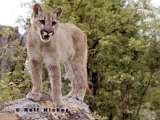 When you are out in the wilderness, it is helpful to know the signs of the cougar, which might tell you that the cat has been by recently, and could still be in the area. This information can be helpful for self-protection, but it is also interesting for its own sake, to be able to understand and interpret the clues in nature.
When you are out in the wilderness, it is helpful to know the signs of the cougar, which might tell you that the cat has been by recently, and could still be in the area. This information can be helpful for self-protection, but it is also interesting for its own sake, to be able to understand and interpret the clues in nature.
Cougars leave the same types of signs as many other animals: scat, marks on trees, and tracks. A cougar might also leave uneaten food lying around for a while. Depending on the size of the animal it has killed, it might take a few days for a cougar to consume the entire body. The cougar covers its food cache with a thin layer of dirt and leaves. If you ever find such a cache, you might want to leave the area immediately, as it is very likely the cougar is nearby. But perhaps take a minute or two to look for signs of the kill, such as blood on the ground or drag marks. The cougar will also mark the cache by leaving the scent of its urine nearby, scratching up dirt to cover the urine.
Cougar claw marks on trees are a rare and precious find. With territories as big as 100 square miles or more, the chance of finding the tree a cougar has scratched is smaller than finding a needle in a haystack! Cougar scratch marks can be as high as six feet from the ground, or lower down. Sometimes cougars will use the same tree several times, so there could be multiple sets of claw marks. According to Barbara Butler, author of the fascinating book Wilderness Tracks: How to Sleuth Out Wild Creatures and Wayward Humans, the spaces between cougar claw marks are narrower than those of bears. However, this isn’t that helpful unless you are familiar with the width of the space between bear claws! Barbara luckily provides some additional information: the fore print of a cougar is 3.5″ wide, versus the print of a bear, which is 3¾ – 4″ wide. Ian Sheldon and Tamara Hartson, in Animal Tracks of British Columbia, provide a bigger range: 3.3 – 4.8″ width for cougar fore prints, versus 3.8 – 5.5″ for black bears. Clearly, there could be quite an overlap, making identification based on the claw marks alone unreliable.
However, there are usually other signs nearby for the watchful tracker. Cougar scat is often composed of chunks of dense whitish matter, about the size of charcoal briquettes. There is usually a lot of fur in the scat. Whereas bear scat is usually a big pile or several pieces of looser material, ranging from blackish to reddish, depending on what the bear has been eating. In the later summer and fall there will be lots of berries in bear scat. At other times grass and twig bits are more common.
 And then there is the track itself. It is easy to distinguish between a cougar print and a bear print if the print is clear. Look for animal tracks in mud, soft sand, snow, or bare dirt. Bear rear foot prints look almost like a human foot print, longer than wide, with tapered heel, and often all five toes displaying clearly, with the claw mark well in front of the end of the toe. Cougar prints are roundish in shape, with four toes, and the claws seldom show. Barbara says that cougar claws register about 5% of the time.
And then there is the track itself. It is easy to distinguish between a cougar print and a bear print if the print is clear. Look for animal tracks in mud, soft sand, snow, or bare dirt. Bear rear foot prints look almost like a human foot print, longer than wide, with tapered heel, and often all five toes displaying clearly, with the claw mark well in front of the end of the toe. Cougar prints are roundish in shape, with four toes, and the claws seldom show. Barbara says that cougar claws register about 5% of the time.
I took this picture of a cougar track beside the barn at Monkey Valley, a few springs ago. I spent quite a while looking around the area nearby, but didn’t see any other signs of the cougar. The hind print is slightly smaller, almost registering over the front print in this example. It seems the cougar must have had its thick winter fur on, obscuring some of the details of the print, such as the front lobe, which is usually clearly divided in two, and the toe prints. Here the front middle toes have blended together. Notice that the prints are wider than long… (to be continued)
















